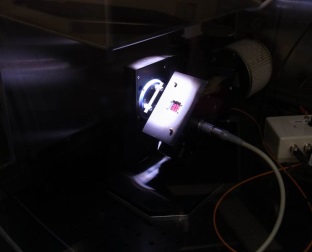Light Management for Organic Solar Cells
Flexibility. Printability. Semitransparency. These features render organic solar cells perfectly suitable for window and facade integration. As sun tracking is impossible for these stationary applications, the angle-dependent absorption of organic solar cells becomes very important. Utilizing optical and electrical characterization methods as well as optical simulations, we investigate the performance of organic solar cells under oblique illumination.
 |
Solar cells are usually characterized under normal incident illumination using a “simulated sun” (e.g. a filtered Xenon arc lamp). In real life scenarios the illumination source, our sun, changes its position with respect to the solar cell and hence the solar cell faces oblique illumination. We constructed a rotating sample holder for the characterization of organic solar cells under varying angles of illumination. Organic solar cells show an angle-independent performance for angles of illumination up to 65° which is more than sufficient for building integrated applications, windows and all other stationary installations. Furthermore, we investigated the angle-dependence of organic tandem solar cells, where two solar cells are stacked on top of each other to increase the overall efficiency of the device. Even though with the devices exhibit more than twice the number of different layers, we observe the same angle-independence as in in the single-junction devices. |
Further reading:
- J. Mescher et al., Illumination angle and layer thickness influence on the photo current generation in organic solar cells: A combined simulative and experimental study, AIP Advances, 2015, 5, 077188, DOI: 10.1063/1.4928074.